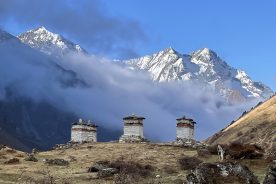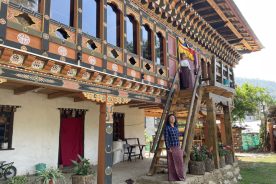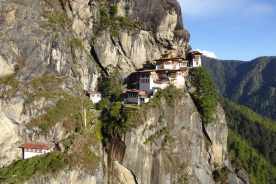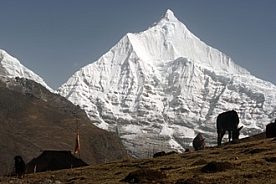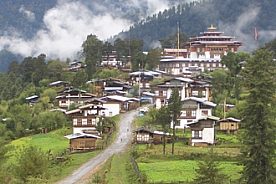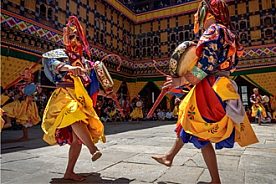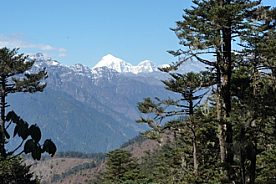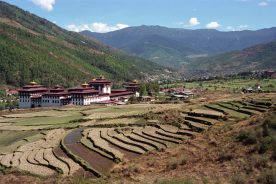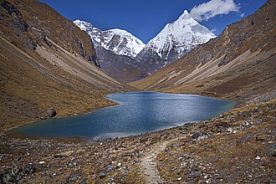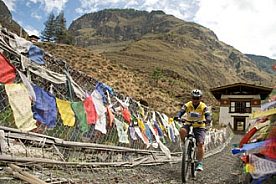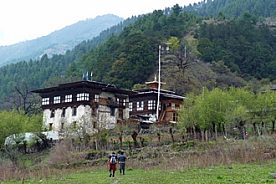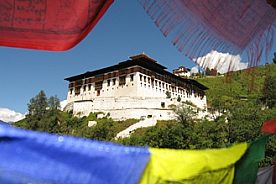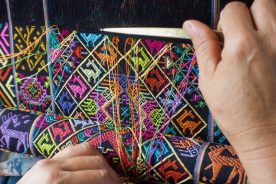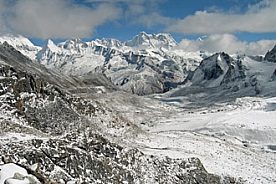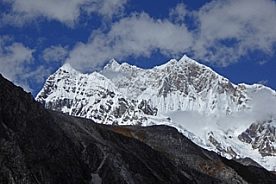Our grading system explained
What makes Bhutan so special?
Known as the ‘Kingdom of the Thunder Dragon’ by its people, Bhutan is a beautiful and profoundly spiritual country with striking mountains, vibrant Buddhist festivals and a fascinating traditional way of life. Whether you go on a cultural tour of Bhutan or a trekking holiday in Bhutan, Mountain Kingdoms is the Himalayan specialist to turn to. Our expertise, built on over 36 years of running small group and tailor made holidays in Bhutan, will give you an unforgettable experience. Our Bhutan holidays are the very best way to get under the skin of this remarkable Himalayan nation whether you are in Bhutan trekking, walking or simply sightseeing.
Our walking and trekking tours in Bhutan will take you deep into the isolated mountains and valleys of the country. Our high mountain treks focus on trekking amidst the highest peaks and passes in Bhutan whilst other routes stray off-the-beaten-track, following old trade and smuggling routes rarely visited by foreigners.
Cultural tours to Bhutan typically revolve around one of the country’s many fascinating Buddhist festivals with amazing displays of national celebration and religious devotion. Our Bhutan tours also give you a unique opportunity to visit remote villages and experience the traditional Bhutanese way of life.
Whatever you want from your visit to this unique country, Mountain Kingdoms will have a trek or tour for you, and, if we don’t, we can always help you to design your own! Alongside our standard group itineraries, we also offer Tailor Made holidays to Bhutan, allowing us to create the perfect trip to suit your needs. Whether you take a trekking holiday along Bhutan’s ancient trade routes, climb the highest mountains, explore remote villages or take a tour of Bhutan’s main cultural centres and sights, Mountain Kingdoms' holidays in Bhutan will take you right to the heart of the Kingdom of the Thunder Dragon. Our holidays in Bhutan include the services of an expert guide, driver and a support crew if your trekking. And our Bhutan holiday packages come complete with good standard hotel accommodation, all your meals from arrival to departure, private transport and entrance fees for all sightseeing. We also obtain your visa to enter Bhutan and include the cost of flights between Kathmandu and Bhutan as well as any internal flights that you might take as part of your holiday in Bhutan.
Bhutan Trekking Holidays & Tours
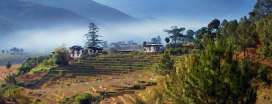
Timeless traditions, unique architecture and stunning Himalayan scenery combine to make Bhutan the most fascinating of all the Himalayan kingdoms.
16 Holidays
- A new, high mountain trail crossing seven passes over 4,000m
- Excellent acclimatisation and two rest days
- A full day to explore Chomolhari Base camp
- Descend to the famous Tiger's Nest on a lesser-known path
- Stunning Soi Yaksey Valley with its abandoned cliff treasury
- Sacred lakes, a pilgrim's trail and 'sky burial' sites
- Full service camping on trek
Flight inclusive from £5675, Land only from £4525
- Get first-hand insight into Bhutanese culture, traditions and way of life.
- Attend a Tibetan Buddhist festival.
- Enjoy many interesting day walks, including Tiger's Nest Monastery.
- Visit beautiful off-the-beaten-track valleys.
- Stay in handpicked homestays, good quality hotels and a deluxe camp on trek
- Trek for two days over the Saga La Pass to Drugyel Dzong in the Paro Valley.
Flight inclusive from £4695, Land only from £3395
- A three day trek between villages and temples along the ridgeline of the Kathmandu Valley
- Follow in the footsteps of pilgrims on the trail to the sacred temple of Namo Buddha
- An overnight camping trek in Bhutan to reach Taktsang Monastery
- Time to explore the heritage towns of Bhaktapur, Dhulikel and Panauti in Nepal
- Gentle walks in Bhutan and the cultural highlights of Paro, Punakha and Thimphu
- All the colour and celebrations of a traditional Bhutanese festival
Flight inclusive from £4775, Land only from £3425
- Walk and trek the best sections of the western end of Bhutan's new long-distance trail
- Experience traditional rural life, ancient cultural sights and beautiful scenery
- Avoid the toughest climbs of the trail with a carefully selected itinerary
- Visit Taktsang Monastery, the Tiger's Nest, and Punakha Dzong
Flight inclusive from £4500, Land only from £3250
- A fully supported, well-paced trek with excellent acclimatisation
- Trek to the Base Camp of Mount Chomolhari and return via the high pass of the Yeli La
- Join the celebrations at the Chomolhari Mountain Festival (October departure)
- Walk to Taktsang Monastery and sightseeing in Thimphu
- Enjoy first-rate camping facilities on trek and good quality hotels in Bhutan and Kathmandu
Flight inclusive from £5145, Land only from £3995
- Explore the cultural highlights of Bhutan including iconic Taktsang Monastery and Punakha Dzong
- First-rate accommodation in Bhutan using comfortable hotels and lodges
- Relax at Dwarika’s heritage hotel in Kathmandu
- Excellent and varied programme of gentle walks
- Join the flamboyant celebrations at a Bhutanese festival
Flight inclusive from £4945, Land only from £3950
- Visit the key cultural sights including the Tiger’s Nest Monastery and Punakha Dzong
- Explore picturesque villages and get under the skin of authentic Bhutanese culture
- Join the celebrations at a Bhutanese festival
- Stay in a 5 star hotel in Kathmandu before and after visiting Bhutan
Flight inclusive from £4675, Land only from £3375
- Trek one of Bhutan’s oldest trails with wonderfully varied scenery and superb mountain views
- Walk to the fabled Tiger’s Nest Monastery and visit Punakha Dzong
- Explore the key cultural sights of Thimphu and the Paro Valley
- Attend a festival (on selected departures)
- Enjoy first-rate camping and well-appointed hotels
Flight inclusive from £4650, Land only from £3350
- Explore the artistic and cultural heritage of ancient Kathmandu
- Enjoy stunning views of the Himalayan mountains
- Visit all the key cultural sights in Bhutan, including iconic Taktsang Monastery
- Experience traditional Nepalese village life in Bandipur
- Enjoy time in scenic Pokhara with a boat ride on the lake
- Stay in comfortable hotels throughout
Flight inclusive from £4520, Land only from £3495
- Spectacular scenery from start to finish
- Reach the base camp of Bhutan's second highest mountain
- Spend time in the remote mountain village of Laya
- Attend the Royal Highland Festival on our autumn departure
- Enjoy first-rate camping facilities on trek and a 4* hotel in Kathmandu
Flight inclusive from £5950, Land only from £4850
- Climb stunning passes and be rewarded by exhilarating descents
- Ride from Paro to Bumthang on a tremendously varied route
- Visit villages, dzongs and the famous Taktsang Monastery
- Spend two nights in a traditional village homestay
- Join the celebrations at a Bhutanese festival
Flight inclusive from £6300, Land only from £4950
- Explore the spectacular and little visited hill-top towns and temples of east Bhutan.
- Join the celebrations at a vibrant Bhutanese festival (autumn departure)
- Visit the picturesque village of Ura and stay in a traditional farmhouse for one night.
- Cross the high Thrumshing La on an exciting drive to Mongar.
- Enjoy gentle walks in the beautiful valleys around Bumthang.
Flight inclusive from £5645, Land only from £4845
- Spend several nights in approved farmhouse homestays to experience the lives of the local people.
- Trek for two days on the Bumdra Trek to reach celebrated Taktsang Monastery.
- Enjoy varied and interesting day walks.
- Discover the beautiful 'hidden' valleys of Phobjika and Haa.
- Join the festivities at a Bhutanese tsechu.
Flight inclusive from £4825, Land only from £3695
- Experience first-hand the unique textile traditions of Bhutan in the company of Sue Lawty, one of the foremost textile artists in Britain
- Meet local weavers and learn about the rich Bhutanese culture of spinning and weaving
- Visit small villages and stay in homestay accommodation to experience life with a Bhutanese family
- See the key cultural highlights and enjoy walks in the beautiful Bhutanese countryside
- Join the revelries at two colourful local festivals
Flight inclusive from £7095, Land only from £6270
- The classic Snowman trek with a superb hike out through uncharted terrain
- Travel with a highly experienced Mountain Kingdoms leader supported by a Bhutanese guide and crew
- Excellent acclimatisation with carefully placed rest days in the best locations for exploration
- Spend a full day at the Royal Highland Festival in Laya
- Sightseeing in Paro and Punakha including the walk to Tiger's Nest Monastery
- Two nights getting to know the people of Laya with their unique dress and cultural traditions
- First-rate camping on trek and a four-star hotel in Kathmandu
Flight inclusive from £13840, Land only from £12490
- Explore the incredible wild country south of Gangkar Punsum
- Trek through the rarely visited Chamkhar Chhu valley
- Enjoy close up views of Bhutan's highest peak
- Walk up to the breathtaking clifftop temple of Taktsang Monastery
Flight inclusive from £7900, Land only from £6550
- 1
Introduction
The tiny Kingdom of Bhutan in the eastern Himalaya, has successfully remained isolated from the outside world for many centuries. It is a land of supernatural legends, ancient monastery fortresses and, even today, the Bhutanese people live their lives according to time-honoured cultural traditions and deeply held Buddhist beliefs.
Our Definitive Cultural Tour of Bhutan will take you under-the-skin of Bhutanese society into the interior of the Thunder Dragon kingdom where you’ll have the chance to visit villages, monasteries and view points as well as attend a vibrant festival. Or, for a Bhutan adventure tour with a difference try our Cultural Cycling Tour of Bhutan or specialist textiles tour led by Sue Lawty - the Weavers' Trail.
With its immensely scenic landscapes there are endless opportunities for walking or trekking holidays in Bhutan. Well-established trails will take you to secluded villages, past crumbling temples, through deeply forested valleys and up to view points from which you can survey the high Himalayan peaks in the distance. For easy-paced walking holidays that combine superlative scenery with visits to the key cultural sights our Gentle Walking Bhutan or Gentle Walking Eastern Bhutan showcase the best of the country and are unsurprisingly amongst our most popular holidays in Bhutan. Or, if you want to experience traditional Bhutanese life and discover more off-the-beaten-track paths, our Temple Trails & Homestays holiday in Bhutan is a very rewarding way to explore the kingdom.
For more energetic exertions, Bhutan offers a full range of trekking experiences. The Druk Path Trek makes an excellent first Bhutan trekking holiday taking you through magnificent mountain country between Paro and Thimphu. You can also trek into the Hidden Valleys of Bhutan - spending some nights in traditional farmhouse homestays for a really authentic experience.
For the serious trekker, the high mountains of Bhutan provide a magnificent and rewarding challenge. Although climbing in Bhutan maybe forbidden, you can trek to the base camp at Mount Chomolhari, or continue from Chomolhari over several high passes to the remote villages of Lingshi and Laya on our Lingshi Laya Trek. And, if you’re feeling extra adventurous then the Lunana Snowman Trek is undoubtedly the ultimate Himalayan trekking challenge. You can also embark on a journey of discovery on our Rodang La Eastern Bhutan trekking holiday that ventures into the least visited areas of Bhutan following an ancient trading route.
From gentle walking holidays and leisurely cultural tours to challenging treks and cycling adventures, Mountain Kingdoms proudly offers more tours to Bhutan than any other Bhutan tour operator.
Related articles:
Planning a trip to Bhutan: Everything you need to know
The best things to do in Bhutan
Eastern Bhutan - discover the other side of the Thunder Dragon Kingdom
What are the top 10 things to see in Bhutan
A guide to festivals in Bhutan
Key Facts
- Capital city: Thimphu
- Arrival airport: Paro
- Population: 819,000 (approx. 2018)
- Area of country: 38,394 sq km, 14,824,006 sq mi
- Currency: Bhutanese Ngultrum
- Time difference: GMT plus 6 hours
- Popular dishe/s: Ema Datsi (Chillies and cheese)
- Popular drink/s: tea (ngad-ja), bang chhang (homebrew beer), arra (rice spirit)
- Power supply: 220 – 240 volts
- Sockets: Mainly 2-pin round although you may also find 3-pin round or UK style sockets
- Official language: Dzongkha
- Religion: Buddhist 75%, Hinduism 25%
- Did you know? The strange looking takin is the national animal of Bhutan.
- Visa: British visitors to Bhutan require a visa. Mountain Kingdoms obtains visas on behalf of our clients travelling on any of our Bhutan trips.
- FCDO advice: FCDO travel advice
Climate
When is the best time to travel to Bhutan?
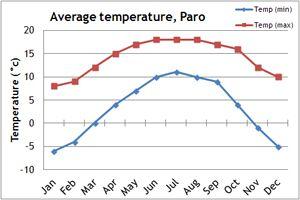
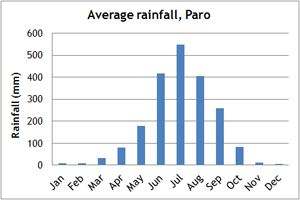
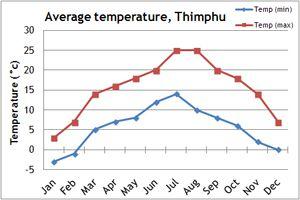
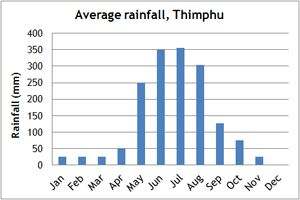
The best time to visit Bhutan is in the spring and autumn. In the spring months of March, April and May you are likely to see blue skies and warm sunshine in the mornings with a build-up of cloud in the afternoon. During the spring months the beautiful rhododendron and magnolia will be in full bloom bringing a wealth of colour to many walking trails. Temperatures can be hot when the sun is out so we would advise wearing sunscreen and a sunhat – especially at higher altitudes. The Paro festival is also held in the spring at Paro Dzong and many of our group holidays include a visit to the festival.
Autumn is considered to be the very best time to visit Bhutan. At this time of the year skies are generally clear with little cloud and rain and the temperatures are lovely and warm; ideal weather for walking or trekking in Bhutan. With the passing of the summer rains, the valleys are lush and verdant and many of Bhutan’s unique species of flora can be seen at their best. Autumn is also the season when the impressive Thimphu tsechu is held.
For more information about Bhutan’s festivals, and when they are held see our festival blog. Some of our group holidays are timed to festivals and we can also organise a Tailor Made holiday to include time at a tsechu.
In winter in Bhutan, the days are generally dry, clear and bright, though the evenings will be cold, and high passes can be blocked by snow. Although a high-altitude trek may not be possible, winter can be a great time to visit Bhutan on a cultural tour or gentle walking holiday, as there are fewer tourists. Bhutan is also a great option for those looking to book a Christmas getaway.
It is possible to travel to Bhutan throughout much of the year, but as our climate charts indicate, the summer months are the monsoon season so the weather is hot and humid with heavy rainfall. We therefore don’t organise any of our group holidays to depart in June, July or August.
It should be noted that the great variations in elevation in Bhutan have a significant impact on temperature and rainfall. The lower altitudes in the south of the country bring a more tropical climate with the greatest precipitation. Whilst the Himalayan north is colder all year round and the highest peaks permanently covered in snow. Even in the central region of Bhutan, where most tourists visit, the higher you are the cooler it will feel. We therefore recommend carrying a couple of additional layers with you, including a good waterproof, windproof jacket, especially if you are out walking.
Whatever time of year you choose to travel to Bhutan we have a comprehensive range of small group tours, treks, walking and cycling holidays, or we can create the perfect Tailor Made Bhutan holiday for you.
Frequently asked Questions
- Which month is best to trek in Bhutan?
-
March and April in the spring or October and November in the autumn are the premium months for trekking in Bhutan especially on the higher mountain trails. If you're planning on walking at lower levels then a trip to Bhutan is an option during the winter months, although January and February can be very cold. The summer months are monsoon season making the trails inaccessible so we do not advise visiting between May and September.
- What is the most difficult trek in Bhutan?
-
The Lunana Snowman Trek is the longest and most challenging of all the trekking holidays in Bhutan that we offer. It involves 14 high passes and 28 days trekking in total and is totally removed from civilisation for much of the trek. We consider it the ultimate Bhutan trekking challenge and should be at the top of the wish list for all high mountain adventurers.
- How much does it cost to trek in Bhutan?
-
The prices of our walking and trekking holidays in Bhutan can be found on our individual holiday pages. Prices for our Bhutan tour packages start from around £4,000 (land only) and include all accommodation, meals, private transport, visa fees and the services of an experienced guide and driver, If you are travelling to Bhutan with us on a trekking holiday we also include a trek support crew, full porterage, and good quality tents and equipment. We can also provide a quote if you are interested in tailor made Bhutan holidays.
- How many days are enough for Bhutan?
-
As Bhutan is such a unique destination with so much cultural and scenic interest we would say that you would want to stay a minimum of a week. This would allow you to tour the key sights in Thimphu, Punakha and the Paro Valley including a walk up to famous Taktsang Monastery. A two week Bhutan trip will allow you to go further afield into some of the lesser-visited valleys such as the Bumthang Valley or the Haa Valley - this will provide some delightful options for day walks. If you want to experience trekking in Bhutan you can do an overnight trek up to the Taktsang Monastery, sample sections of the Trans Bhutan Trail or complete the classic five-day Druk Path Trek. For higher altitude treks allow a minimum of 17 days for your Bhutan holiday, but you could stay for around five weeks if you are doing the Lunana Snowman trek.





